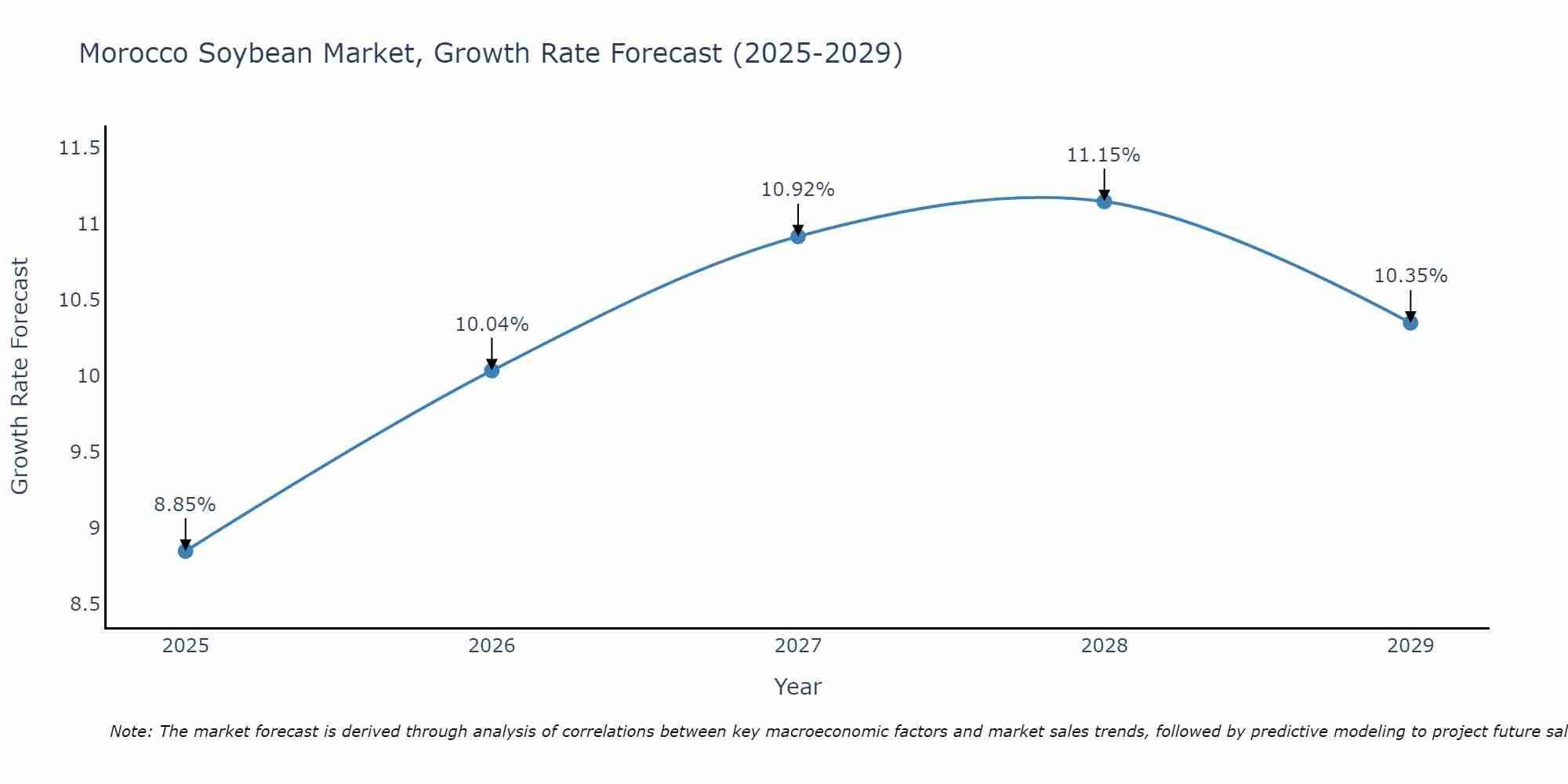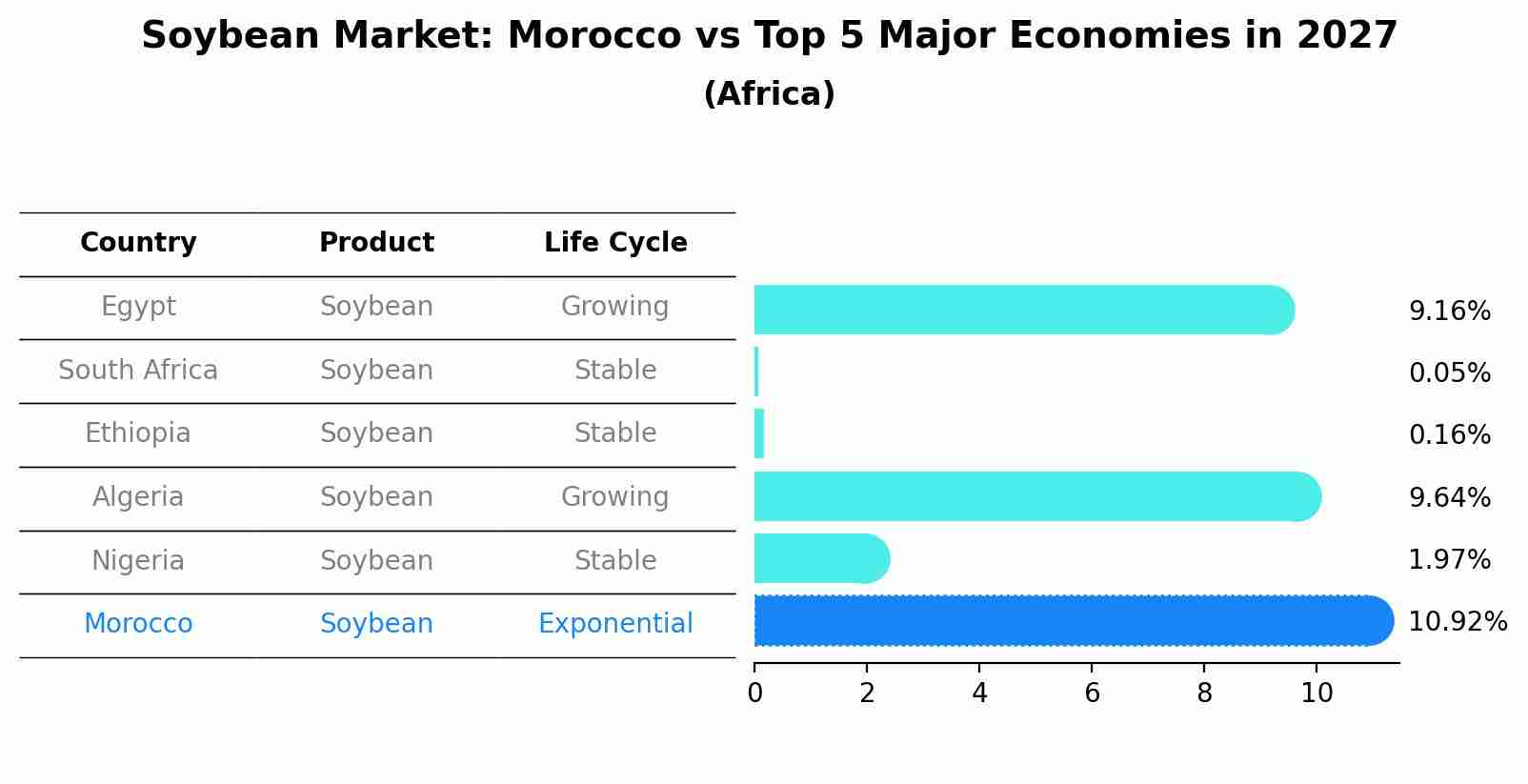Morocco Soybean Market Outlook | Trends, Revenue, Value, Growth, Size, Forecast, COVID-19 IMPACT, Share, Companies, Analysis & Industry
| Product Code: ETC224693 | Publication Date: Aug 2022 | Updated Date: Aug 2025 | Product Type: Market Research Report | |
| Publisher: 6Wresearch | Author: Shubham Deep | No. of Pages: 75 | No. of Figures: 35 | No. of Tables: 20 |
Morocco Soybean Market Size Growth Rate
The Morocco Soybean Market is projected to witness mixed growth rate patterns during 2025 to 2029. Starting at 8.85% in 2025, the market peaks at 11.15% in 2028, and settles at 10.35% by 2029.

Soybean Market: Morocco vs Top 5 Major Economies in 2027 (Africa)
By 2027, Morocco's Soybean market is forecasted to achieve a high growth rate of 10.92%, with Egypt leading the Africa region, followed by South Africa, Ethiopia, Algeria and Nigeria.

Morocco Soybean Market Overview
The Morocco soybean market has been steadily growing in recent years due to increasing demand for soybean products in various industries such as animal feed, food processing, and biodiesel production. The country relies heavily on soybean imports to meet its domestic consumption needs, with major suppliers including the United States, Brazil, and Argentina. The demand for soybeans is driven by the growing livestock sector, as soybean meal is a key component in animal feed formulations. Additionally, the rising health consciousness among consumers has led to a higher consumption of soy-based products in the food industry. Despite facing challenges such as price volatility and competition from other oilseeds, the Morocco soybean market is expected to continue its growth trajectory in the coming years.
Morocco Soybean Market Trends
As of now, the Morocco Soybean Market is experiencing a growing demand for soybean products due to the increasing awareness of the health benefits associated with soy consumption. This trend is driven by a rising interest in plant-based protein sources and the popularity of soy-based products such as tofu, soy milk, and soybean oil. Additionally, the livestock industry in Morocco is also contributing to the demand for soybeans as a key ingredient in animal feed. The government`s efforts to promote sustainable agriculture practices and reduce reliance on imported soybean products are further shaping the market dynamics. Overall, the Morocco Soybean Market is witnessing a shift towards higher consumption and domestic production to meet the growing demand for soybean-derived products.
Morocco Soybean Market Challenges
In the Morocco Soybean Market, a major challenge is the country`s heavy reliance on soybean imports to meet domestic demand for soy products. This dependency on imports makes the market vulnerable to fluctuations in international prices, currency exchange rates, and trade policies. Additionally, limited domestic production of soybeans due to unfavorable climatic conditions further exacerbates the issue. The lack of local infrastructure and technology for soybean farming also hinders the development of a competitive domestic industry. Furthermore, regulatory barriers and import restrictions imposed by the government can create uncertainties for market players. Overall, these challenges pose significant obstacles for the growth and sustainability of the soybean market in Morocco.
Morocco Soybean Market Investment Opportunities
Investment opportunities in the Morocco Soybean Market are promising due to the country`s increasing demand for soybean products in various industries such as animal feed, food processing, and biofuels. With limited domestic production, Morocco heavily relies on imports to meet its soybean needs, presenting opportunities for investors to establish partnerships with local distributors or directly import and supply soybeans to the market. Additionally, the Moroccan government has been promoting agricultural development and modernization, creating a favorable environment for investments in the soybean sector. Investors can also explore opportunities in value-added products like soybean oil and soy-based food products to cater to the growing consumer demand for healthy and sustainable alternatives. Overall, the Morocco Soybean Market offers potential for growth and diversification for investors looking to capitalize on the country`s expanding agricultural sector.
Morocco Soybean Market Government Policy
The Moroccan government has implemented various policies to support the soybean market in the country. These policies include subsidies for soybean production, import tariffs on soybean products to protect domestic farmers, and incentives to increase local soybean processing capacity. Additionally, the government has established regulations to ensure the quality and safety of soybean products in the market. These policies aim to promote self-sufficiency in soybean production, reduce dependency on imports, and stimulate growth in the domestic soybean industry. Overall, the government`s support for the soybean market aligns with its efforts to enhance food security, boost agricultural productivity, and create economic opportunities for farmers in Morocco.
Morocco Soybean Market Future Outlook
The future outlook for the Morocco Soybean Market appears promising as the country continues to increase its soybean imports to meet the growing demand for livestock feed and oil production. With a rising population and changing dietary preferences towards more protein-rich diets, the demand for soybeans is expected to remain strong. Additionally, government initiatives to support domestic soybean production through subsidies and incentives could further boost the market. However, challenges such as limited arable land and water resources may hinder the expansion of soybean cultivation in Morocco. Overall, the Morocco Soybean Market is likely to see steady growth in the coming years, driven by increasing demand and supportive government policies.
Key Highlights of the Report:
- Morocco Soybean Market Outlook
- Market Size of Morocco Soybean Market, 2021
- Forecast of Morocco Soybean Market, 2031
- Historical Data and Forecast of Morocco Soybean Revenues & Volume for the Period 2018 - 2031
- Morocco Soybean Market Trend Evolution
- Morocco Soybean Market Drivers and Challenges
- Morocco Soybean Price Trends
- Morocco Soybean Porter's Five Forces
- Morocco Soybean Industry Life Cycle
- Historical Data and Forecast of Morocco Soybean Market Revenues & Volume By Applications for the Period 2018 - 2031
- Historical Data and Forecast of Morocco Soybean Market Revenues & Volume By Crush for the Period 2018 - 2031
- Historical Data and Forecast of Morocco Soybean Market Revenues & Volume By Feed Use for the Period 2018 - 2031
- Historical Data and Forecast of Morocco Soybean Market Revenues & Volume By Food Use for the Period 2018 - 2031
- Morocco Soybean Import Export Trade Statistics
- Market Opportunity Assessment By Applications
- Morocco Soybean Top Companies Market Share
- Morocco Soybean Competitive Benchmarking By Technical and Operational Parameters
- Morocco Soybean Company Profiles
- Morocco Soybean Key Strategic Recommendations
Frequently Asked Questions About the Market Study (FAQs):
1 Executive Summary |
2 Introduction |
2.1 Key Highlights of the Report |
2.2 Report Description |
2.3 Market Scope & Segmentation |
2.4 Research Methodology |
2.5 Assumptions |
3 Morocco Soybean Market Overview |
3.1 Morocco Country Macro Economic Indicators |
3.2 Morocco Soybean Market Revenues & Volume, 2021 & 2031F |
3.3 Morocco Soybean Market - Industry Life Cycle |
3.4 Morocco Soybean Market - Porter's Five Forces |
3.5 Morocco Soybean Market Revenues & Volume Share, By Applications, 2021 & 2031F |
4 Morocco Soybean Market Dynamics |
4.1 Impact Analysis |
4.2 Market Drivers |
4.2.1 Increasing demand for soybean products in Morocco due to changing dietary preferences and increasing health consciousness. |
4.2.2 Growth in the livestock industry in Morocco, driving the demand for soybean meal as animal feed. |
4.2.3 Government initiatives to promote domestic soybean production and reduce dependence on imports. |
4.3 Market Restraints |
4.3.1 Volatility in international soybean prices affecting the cost competitiveness of imported soybeans. |
4.3.2 Limited arable land and water resources for soybean cultivation in Morocco. |
4.3.3 Lack of advanced technology and infrastructure for soybean cultivation and processing in the country. |
5 Morocco Soybean Market Trends |
6 Morocco Soybean Market, By Types |
6.1 Morocco Soybean Market, By Applications |
6.1.1 Overview and Analysis |
6.1.2 Morocco Soybean Market Revenues & Volume, By Applications, 2021-2031F |
6.1.3 Morocco Soybean Market Revenues & Volume, By Crush, 2021-2031F |
6.1.4 Morocco Soybean Market Revenues & Volume, By Feed Use, 2021-2031F |
6.1.5 Morocco Soybean Market Revenues & Volume, By Food Use, 2021-2031F |
7 Morocco Soybean Market Import-Export Trade Statistics |
7.1 Morocco Soybean Market Export to Major Countries |
7.2 Morocco Soybean Market Imports from Major Countries |
8 Morocco Soybean Market Key Performance Indicators |
8.1 Percentage increase in domestic soybean production year-on-year. |
8.2 Adoption rate of modern agricultural practices in soybean cultivation. |
8.3 Percentage of soybean meal used in the livestock industry produced domestically. |
8.4 Average yield per hectare of soybean cultivation in Morocco. |
8.5 Percentage of soybean import dependency reduced over a specific period. |
9 Morocco Soybean Market - Opportunity Assessment |
9.1 Morocco Soybean Market Opportunity Assessment, By Applications, 2021 & 2031F |
10 Morocco Soybean Market - Competitive Landscape |
10.1 Morocco Soybean Market Revenue Share, By Companies, 2021 |
10.2 Morocco Soybean Market Competitive Benchmarking, By Operating and Technical Parameters |
11 Company Profiles |
12 Recommendations |
13 Disclaimer |
- Single User License$ 1,995
- Department License$ 2,400
- Site License$ 3,120
- Global License$ 3,795
Search
Thought Leadership and Analyst Meet
Our Clients
Related Reports
- Afghanistan Apparel Market (2026-2032) | Growth, Outlook, Industry, Segmentation, Forecast, Size, Companies, Trends, Value, Share, Analysis & Revenue
- Canada Oil and Gas Market (2026-2032) | Share, Segmentation, Value, Industry, Trends, Forecast, Analysis, Size & Revenue, Growth, Competitive Landscape, Outlook, Companies
- Germany Breakfast Food Market (2026-2032) | Industry, Share, Growth, Size, Companies, Value, Analysis, Revenue, Trends, Forecast & Outlook
- Australia Briquette Market (2025-2031) | Growth, Size, Revenue, Forecast, Analysis, Trends, Value, Share, Industry & Companies
- Vietnam System Integrator Market (2025-2031) | Size, Companies, Analysis, Industry, Value, Forecast, Growth, Trends, Revenue & Share
- ASEAN and Thailand Brain Health Supplements Market (2025-2031) | Strategy, Consumer Insights, Analysis, Investment Trends, Opportunities, Growth, Size, Share, Industry, Revenue, Segments, Value, Segmentation, Supply, Forecast, Restraints, Outlook, Competition, Drivers, Trends, Demand, Pricing Analysis, Competitive, Strategic Insights, Companies, Challenges
- ASEAN Bearings Market (2025-2031) | Strategy, Consumer Insights, Analysis, Investment Trends, Opportunities, Growth, Size, Share, Industry, Revenue, Segments, Value, Segmentation, Supply, Forecast, Restraints, Outlook, Competition, Drivers, Trends, Demand, Pricing Analysis, Competitive, Strategic Insights, Companies, Challenges
- Europe Flooring Market (2025-2031) | Outlook, Share, Industry, Trends, Forecast, Companies, Revenue, Size, Analysis, Growth & Value
- Saudi Arabia Manlift Market (2025-2031) | Outlook, Size, Growth, Trends, Companies, Industry, Revenue, Value, Share, Forecast & Analysis
- Uganda Excavator, Crane, and Wheel Loaders Market (2025-2031) | Strategy, Consumer Insights, Analysis, Investment Trends, Opportunities, Growth, Size, Share, Industry, Revenue, Segments, Value, Segmentation, Supply, Forecast, Restraints, Outlook, Competition, Drivers, Trends, Demand, Pricing Analysis, Competitive, Strategic Insights, Companies, Challenges
Industry Events and Analyst Meet
Whitepaper
- Middle East & Africa Commercial Security Market Click here to view more.
- Middle East & Africa Fire Safety Systems & Equipment Market Click here to view more.
- GCC Drone Market Click here to view more.
- Middle East Lighting Fixture Market Click here to view more.
- GCC Physical & Perimeter Security Market Click here to view more.
6WResearch In News
- Doha a strategic location for EV manufacturing hub: IPA Qatar
- Demand for luxury TVs surging in the GCC, says Samsung
- Empowering Growth: The Thriving Journey of Bangladesh’s Cable Industry
- Demand for luxury TVs surging in the GCC, says Samsung
- Video call with a traditional healer? Once unthinkable, it’s now common in South Africa
- Intelligent Buildings To Smooth GCC’s Path To Net Zero


















